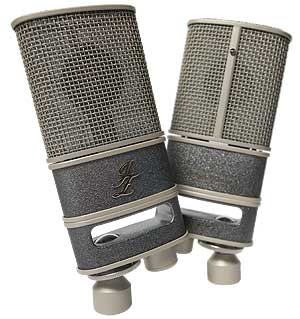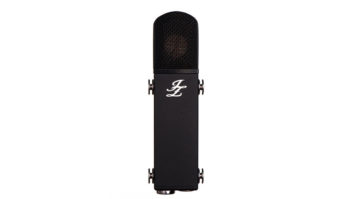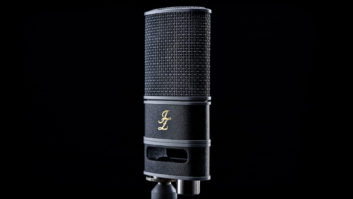
The JZ V47 and V67 are made in Latvia and feature a 1-inch capsule and integrated shock-mount.
Designed by Juris Zarins and made in Latvia, JZ Microphones created its V67 and V47 models with a vintage pedigree in mind. The designer sought to offer a “new and renewed” view of the legendary sound of Neumann’s U47 and U67 tube microphones, using Class-A discrete electronics. On the outside, both mics look exactly alike and are identified by the gold label on the rear. Inside, the two differ in proprietary design but both are fixed cardioid and phantom powered, and have 1-inch, double-diaphragm capsules made with JZ’s patented Golden Drops sputtering technology.
The unique “flask” design and internal shock-mounting system make it easy to get the mics into tight spots, as does the ball-and-socket swivel that provides a limited-range method of fine-tuning your mic placement. Both are nearly flat from 30 to 20k Hz, and handle 134dB max SPLs with 0.5-percent THD @ 1,000-ohm load. Neither has a bass roll-off nor a pad.
IN THE STUDIO
I had both mics on hand across a number of duplicate same-day sessions and could A/B them while swapping them around. First, I used the V47 about six inches away from the outside head of a kick drum recorded through a Groove Tubes SuPre preamp with the input impedance set to 1,200. It sounded great paired with a Shure Beta 52 inside the drum with a heavy scoop taken out at 400 Hz, offering lots of kick-in-your-chest low frequencies with great transient presence. The mic handled the level without wincing, yielding plenty of clean output that necessitated a pad at the preamp. The V67 was equally good in this application; it offered nearly identical results, but had decidedly less low end.
Placed 2.5 feet above the cymbals and centered on a drum kit, the V67 sounded very good. I also used the V47 in this application but preferred the V67 as the latter brought out the transient hits of the toms with plenty of bottom end from the kick and lower drums.
I then tried the mics on acoustic bass, set about a foot above the bridge and facing upward. The V67 and V47 both excelled in this application, with the V47 offering more bottom end and the V67 yielding better string detail.
When I listened to both mics routed through identical signal chains while recording a male vocal, the V67 was a clear winner. The V47 was good, but the V67’s rich midrange made the track. Both offered a nice rendition of “t”s, “p”s and “s”s without sibilance and exhibited a smooth top end.
The V67 on a Fender guitar amp was rich in tone, providing some needed midrange with an SM57. It was smooth at the top end, lifting the track to just the right place in the mix. While sounding good, the V47 on the same amp didn’t equal the performance of its sibling in this application.
Both mics paired well together on acoustic guitar. I put the V67 on the bottom end near the bridge and the V47 on top at the 12th fret pointing into the center of the guitar. The V47 offered good high-end string detail—without clutter—while the V67’s midrange reproduction gave the instrument a rich tone.
The V67 was a winner when recording a tenor saxophone, with the mic placed about two feet above the bell and pointing in. It nicely represented the deep resonance of the lower range of the instrument and was smooth and never strident in the higher registers. With its sweet midrange, it beat out the V47 in this test.
JOURNEYMEN TRANSDUCERS
After using both mics across a range of sessions and instruments, I am impressed with the JZ V47 and V67. I’m not one for shootouts, but having both mics on hand made it hard to resist. If I had to choose an overall favorite, it would have to be the V67. Its rich midrange repeatedly blew me away with its rendition of the instruments I tried it on. It excelled on guitar amps, over a drum kit, on tenor saxophone and with male vocals. It’s been awhile since I’ve heard a mic that worked so well across a wide range of applications.
On the other hand, the V47 was no slouch, performing better on kick drum and offering more bottom end when used to record a standup bass. The V47 is a good all-around mic, but the V67 repeatedly took it up a notch.
Retailing at $1,999 each, these mics are not inexpensive, but if you’re looking for that magic mic that has a shot at doing it all very well, the V67 is just the ticket, while the V47 offers a bit more bottom end and the same smooth high-frequency detail.

Click on the Product Summary box above to view the Vintage Series product page.


Both mics (V47, top; V67, bottom) show a smooth and fairly
flat frequency response.

The capsule, housing and electronics are handmade
in Latvia.

Both mics feature integral shockmounted capsules.







